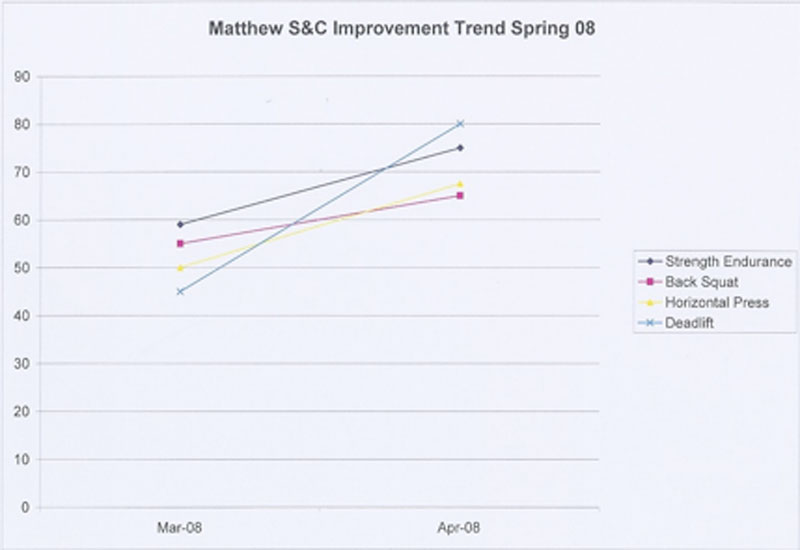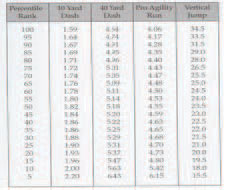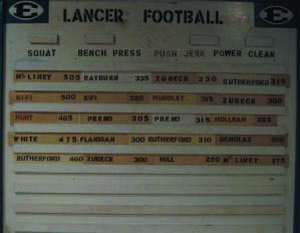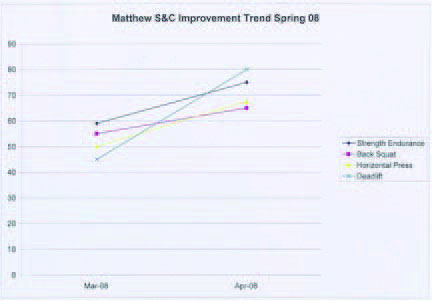Determining The Conditioning Approach

With the last edition of the Performance Menu I addressed the need for trainers and athletes to sell the benefits of training. Without a belief in the benefit the commitment, the athlete/client will lack the fortitude necessary to realize all that is possible during the journey from striver to integrator.
With a belief in the benefit embraced, the coach and athlete can now embark on the conditioning approach. The traditional approach to determining a course of action has four components.

PRE-TESTING Establishing baselines is a cornerstone of this approach. The measures are objective in nature. The coach puts the athlete through a test or series of test to determine the initial level of athletic fitness. These tests can include measures of strength, speed, speed endurance, power, agility, specific skills, balance and anthropometrics. These anthropometrics are by and large the weigh/measure and pinch routine found in 90% of all health club environments. In a one coach/trainer to one athlete/client arrangement, this is a very manageable undertaking. The testing should also look at sport characteristics. Is the sport a team or individual? Where is the competition performed?

EVALUATION Following the testing, the results are then evaluated by the coach and the athlete to determine the athlete’s fitness in the various testing areas. The athlete’s strengths and weaknesses are revealed through this test. During my years with large sports teams, we collected enough data to establish percentile rankings based upon these evaluations and placed them in a graphing program. I found that these visual comparisons proved to be very beneficial. Those setting records in particular areas can be rewarded and/or placed on record boards.
I like the idea of ranking evaluation data into percentile ranks based on position, age, and gender.
Record boards inspire competitive athletes to higher levels of
performance.
GOAL SETTING Ideally, there is a collective determination between coach and athlete of where the athlete needs or wants to be at a predetermined future date. The goals should be specific. Those who say I am going to improve my back squat are not as successful as those who have a target of improving their back squat by 15kg by the post testing. These goals should be at the forefront of the athlete’s mind during each training session.
PROGRAMMING After the goals have been established, the coach will place the athlete into a conditioning program based on the goals that have been established. This is a critical stage. The coach must take into consideration all of the variables associated with a particular trainee and his or her sport/position objectives.
The needs analysis consists of answering some initial questions which affect the others:
-Exercise Movements
Specific Muscles
Joint Angles
Contraction Mode
Loading needs
-Energy Metabolism Used
ATP-PC
Lactic Acid Source
Oxygen Source
-Injury Prevention
Most common sites of possible injury
-Administrative concerns
The athlete’s gender, age, the initial level of conditioning, and injury history are also part of the programming process.

The contemporary coach utilizes benchmarks as part of the programming.
Noting performance trends can reveal much about the process
Administrative concerns will vary from coach to coach and program to program. The size of the training center, the staff available and the knowledge and experience of the coach all factor into the program application.
The contemporary coach uses this opportunity to program benchmarks into the program. Think of these benchmarks as midterm exams. They give both the athlete and the coach an opportunity to reinforce the programming plan. Typically benchmarks can be programmed on a weekly or bi-weekly basis.
The contemporary coach utilizes benchmarks as part of the programming. Noting performance trends can reveal much about the process.
THE ATHLETES LOG
The athlete should have a journal/log in which to record information regarding recovery. Those should include:
-Sleep hours
-Quality of sleep (5 point scale)
-Morning bodyweight
-Morning pulse (resting)
-Appetite
-Desire to train
This log will also have a place to record quantifiable outputs from training. Best efforts of time or load during particular movements or benchmarks are typical measures.
If the contemporary coach is using benchmarks, then the training becomes a testing of sorts. Every session can reveal progress towards the goal(s) established during the goal setting phase.
POST-TESTING
At a predetermined interval, a post testing period is implemented. To keep the experience as controlled as possible, the entire test should be administered in the same order as the pre-test. The environment and time should be the same as was performed initially with as much objectivity as possible. The post-testing data is laid over the pre-test to determine what has been accomplished.
It is not atypical for an athlete to have a bad testing day. This can be mentally crippling for an athlete. The training log and positive returns on benchmark workouts are important in these cases. The coach acting as counselor can most times show the athlete that their efforts were not wasted.
RISE AND REPEAT
Armed with new baseline numbers, the coach and athlete will embark on another plan of attack, working with new perspectives on what the next set of objectives should entail.
With a belief in the benefit embraced, the coach and athlete can now embark on the conditioning approach. The traditional approach to determining a course of action has four components.

PRE-TESTING Establishing baselines is a cornerstone of this approach. The measures are objective in nature. The coach puts the athlete through a test or series of test to determine the initial level of athletic fitness. These tests can include measures of strength, speed, speed endurance, power, agility, specific skills, balance and anthropometrics. These anthropometrics are by and large the weigh/measure and pinch routine found in 90% of all health club environments. In a one coach/trainer to one athlete/client arrangement, this is a very manageable undertaking. The testing should also look at sport characteristics. Is the sport a team or individual? Where is the competition performed?

EVALUATION Following the testing, the results are then evaluated by the coach and the athlete to determine the athlete’s fitness in the various testing areas. The athlete’s strengths and weaknesses are revealed through this test. During my years with large sports teams, we collected enough data to establish percentile rankings based upon these evaluations and placed them in a graphing program. I found that these visual comparisons proved to be very beneficial. Those setting records in particular areas can be rewarded and/or placed on record boards.
I like the idea of ranking evaluation data into percentile ranks based on position, age, and gender.
Record boards inspire competitive athletes to higher levels of
performance.
GOAL SETTING Ideally, there is a collective determination between coach and athlete of where the athlete needs or wants to be at a predetermined future date. The goals should be specific. Those who say I am going to improve my back squat are not as successful as those who have a target of improving their back squat by 15kg by the post testing. These goals should be at the forefront of the athlete’s mind during each training session.
PROGRAMMING After the goals have been established, the coach will place the athlete into a conditioning program based on the goals that have been established. This is a critical stage. The coach must take into consideration all of the variables associated with a particular trainee and his or her sport/position objectives.
The needs analysis consists of answering some initial questions which affect the others:
-Exercise Movements
Specific Muscles
Joint Angles
Contraction Mode
Loading needs
-Energy Metabolism Used
ATP-PC
Lactic Acid Source
Oxygen Source
-Injury Prevention
Most common sites of possible injury
-Administrative concerns
The athlete’s gender, age, the initial level of conditioning, and injury history are also part of the programming process.

The contemporary coach utilizes benchmarks as part of the programming.
Noting performance trends can reveal much about the process
Administrative concerns will vary from coach to coach and program to program. The size of the training center, the staff available and the knowledge and experience of the coach all factor into the program application.
The contemporary coach uses this opportunity to program benchmarks into the program. Think of these benchmarks as midterm exams. They give both the athlete and the coach an opportunity to reinforce the programming plan. Typically benchmarks can be programmed on a weekly or bi-weekly basis.
The contemporary coach utilizes benchmarks as part of the programming. Noting performance trends can reveal much about the process.
THE ATHLETES LOG
The athlete should have a journal/log in which to record information regarding recovery. Those should include:
-Sleep hours
-Quality of sleep (5 point scale)
-Morning bodyweight
-Morning pulse (resting)
-Appetite
-Desire to train
This log will also have a place to record quantifiable outputs from training. Best efforts of time or load during particular movements or benchmarks are typical measures.
If the contemporary coach is using benchmarks, then the training becomes a testing of sorts. Every session can reveal progress towards the goal(s) established during the goal setting phase.
POST-TESTING
At a predetermined interval, a post testing period is implemented. To keep the experience as controlled as possible, the entire test should be administered in the same order as the pre-test. The environment and time should be the same as was performed initially with as much objectivity as possible. The post-testing data is laid over the pre-test to determine what has been accomplished.
It is not atypical for an athlete to have a bad testing day. This can be mentally crippling for an athlete. The training log and positive returns on benchmark workouts are important in these cases. The coach acting as counselor can most times show the athlete that their efforts were not wasted.
RISE AND REPEAT
Armed with new baseline numbers, the coach and athlete will embark on another plan of attack, working with new perspectives on what the next set of objectives should entail.
|
Michael Rutherford (a.k.a. Coach Rut) is the owner of Boot Camp Fitness. He has over a quarter-century of fitness coaching experience with athletes of all ages. He has also worked in hospital wellness environments and rehabilitation clinics. Rut holds academic degrees in biology, physical education, and exercise physiology and sports biomechanics. He is a USAW-certified Club Coach and is a CrossFit level-3 trainer. |
Search Articles
Article Categories
Sort by Author
Sort by Issue & Date
Article Categories
Sort by Author
Sort by Issue & Date

